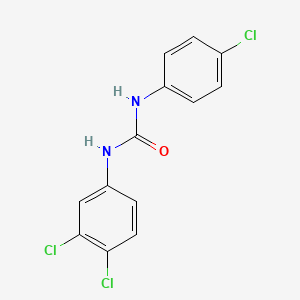D1139 | triclocarban
| Toxicity | Dose | Time | Species | Model | Method | Action | Positive criterion | Reference |
|---|---|---|---|---|---|---|---|---|
| MEMBRANE POTENTIAL | 0.14±0.05 | human | qHTS-HepG2 | MMP assay | decrease | IC50 | 163 | |
| MEMBRANE POTENTIAL | 0.17 | human | HepG2 | MMP assay | decrease | IC50 | 163 | |
| MEMBRANE POTENTIAL | 0.17±0.10 | rat | hepatocytes | MMP assay | decrease | IC50 | 163 | |
| Pictogram | Signal | Statements | Precautionary Statement Codes |
|---|---|---|---|
 |
Warning |
Aggregated GHS information provided by 180 companies from 4 notifications to the ECHA C&L Inventory. Each notification may be associated with multiple companies. H400 (96.67%): Very toxic to aquatic life [Warning Hazardous to the aquatic environment, acute hazard] H410 (100%): Very toxic to aquatic life with long lasting effects [Warning Hazardous to the aquatic environment, long-term hazard] Information may vary between notifications depending on impurities, additives, and other factors. The percentage value in parenthesis indicates the notified classification ratio from companies that provide hazard codes. Only hazard codes with percentage values above 10% are shown. |
P273, P391, and P501; (The corresponding statement to each P-code can be found at the GHS Classification page.) |
 |
Warning |
H400: Very toxic to aquatic life [Warning Hazardous to the aquatic environment, acute hazard] H410: Very toxic to aquatic life with long lasting effects [Warning Hazardous to the aquatic environment, long-term hazard] |
P273, P391, and P501; (The corresponding statement to each P-code can be found at the GHS Classification page.) |
| Organism | Test type | Route | Dose (normalized dose) | Effect | Source |
|---|---|---|---|---|---|
| rabbit | LD50 | skin | > 7940ug/kg (7.94mg/kg) | National Technical Information Service. Vol. OTS0524327-1, | |
| mouse | LD50 | intraperitoneal | 2100mg/kg (2100mg/kg) | Labo-Pharma-Problemes et Techniques. Vol. 27, Pg. 306, 1979. | |
| rat | LD50 | oral | > 34600mg/kg (34600mg/kg) | Toxicology and Applied Pharmacology. Vol. 33, Pg. 171, 1975. | |
| 1-(3',4'-Dichlorophenyl)-3-(4'-chlorophenyl)urea | 1-(4-Chlorophenyl)-3-(3,4-dichlorophenyl)urea | 101-20-2 |
| 3,4'-Trichlorocarbanilide | 3,4'-Trichlorodiphenylurea | 3,4,4'-TRICHLOROCARBANILIDE |
| 3,4,4'-Trichlorocarbanilide, 99% | 3,4,4'-Trichlorodiphenylurea | 3,4,4'-trichloro carbanilide |
| 3,4,4-Trichlorocarbanilide | 3,4,4` Trichlorocarbanilide (Triclocarban), Pharmaceutical Secondary Standard | 3-(4-chlorophenyl)-1-(3,4-dichlorophenyl)urea |
| 4-12-00-01265 (Beilstein Handbook Reference) | 9EG | AC-12602 |
| AI3-26925 | AK163703 | AKOS001713711 |
| AX8081482 | BDBM25730 | BGG1Y1ED0Y |
| BRN 2814890 | C-49798 | C13H9Cl3N2O |
| CAS-101-20-2 | CCRIS 4880 | CHEBI:48347 |
| CHEMBL1076347 | CP 78416 | CS-7760 |
| CTK7G5073 | Carbanilide, 3,4,4'-trichloro- | Carbanilide,4,4'-trichloro- |
| Caswell No. 874 | Certified Reference Material; | Cusiter |
| Cutisan | D06223 | DB11155 |
| DSSTox_CID_6214 | DSSTox_GSID_26214 | DSSTox_RID_78062 |
| DTXSID4026214 | EC 202-924-1 | EINECS 202-924-1 |
| ENT 26925 | EPA Pesticide Chemical Code 027901 | FT-0614114 |
| Genoface | HSDB 5009 | HY-B1805 |
| ICUTUKXCWQYESQ-UHFFFAOYSA-N | J10256 | KS-000000YY |
| KS-5290 | LS-328 | MCULE-7925567906 |
| MFCD00013254 | MLS002415563 | N-(3,4-Dichlorophenyl)-N'-(4-chlorophenyl)urea |
| N-(4-Chlorophenyl)-N'-(3,4-dichlorophenyl)urea | N-(4-Chlorophenyl)-N-(3,4-dichlorophenyl)-Urea | N-(4-chlorophenyl)-N'-(3,4-dichlorophenyl)-urea |
| NCGC00164034-01 | NCGC00164034-02 | NCGC00164034-03 |
| NCGC00164034-04 | NCGC00164034-05 | NCGC00254243-01 |
| NCGC00259579-01 | NCIOpen2_008923 | NSC 72005 |
| NSC-72005 | NSC72005 | Nipaguard TCC |
| Procutene | Q-201865 | Q416579 |
| SCHEMBL68658 | SMR001339078 | SR-01000860289 |
| SR-01000860289-2 | ST011927 | ST24037341 |
| STK730440 | Septivon-Lavril | Solubacter |
| TCC | TCC (soap bacteriostat) | TCC Soap |
| TR-000339 | TRA0036036 | Tox21_112078 |
| Tox21_112078_1 | Tox21_202030 | Tox21_300481 |
| Trichlocarban | Trichlorocarbanilide | Triclocarban |
| Triclocarban (USAN/INN) | Triclocarban [USAN:INN] | Triclocarban, United States Pharmacopeia (USP) Reference Standard |
| Triclocarban, analytical standard | Triclocarbanum | Triclocarbanum [INN-Latin] |
| Trilocarban | UNII-BGG1Y1ED0Y | US8815951, 3-(4-chlorophenyl)-1-(3,4-dichlorophenyl)urea |
| Urea, N-(4-chlorophenyl)-N'-(3,4-dichlorophenyl)- | Urea,4-dichlorophenyl)- | Urea-based compound, 11 |
| WLN: GR DMVMR CG DG | ZINC121480 | [(3,4-dichlorophenyl)amino]-N-(4-chlorophenyl)carboxamide |
| cid_7547 | s6444 | trichlorcarban |

